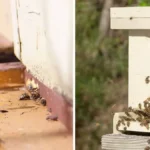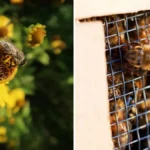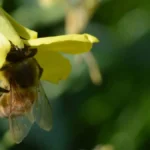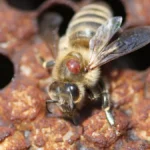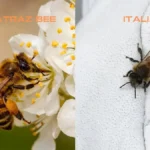In this article, we look at the relative similarities and differences between Carniolan vs Russian bees. This is a relatively simple comparison between two bees adapted to tolerate long cold winters and rapid spring honey flows.
A Brief History Of The “Russian Bee”
Russia is very big. It consists of a number of zones, with the Far Eastern zone being a region in which the indigenous bee is Apis cerana. Varroa destructor is a natural parasite of Apis cerana. With the development of beekeeping in Far Eastern Russia in the 1800’s bees from Western Europe and Central Europe were imported to this Far Eastern region. This resulted in Apis mellifera and Apis cerana coming into close proximity. The varroa mite jumped species.
Over time, the selective breeding of bees that flourished in the Far Eastern Region selected for bees with a natural level of varroa resistance. These bees are not called “Russian Bees” in Russia but rather Apis mellifera Far Eastern strain.
Arrival In The USA
When the varroa mite reached the USA in 1987. It spread rapidly through the heavily managed US bee population causing significant damage. The Honeybee Breeding, Genetics & Physiology Laboratory in Baton Rouge, Louisiana imported queens from these Russian Far Eastern Breed Apis mellifera in 1997. These bees were established on Grand Terre Island. This is a barrier island of the coast of Louisiana. The remoteness of this island ensures to a certain extent that the Russian Bee gene lines stay relatively clean.
The bees chosen for use in the US were from stock that showed resistance to varroa – with nearly 2x more resistant traits to mites than US bees displayed.
Carniolan Bees
Apis mellifera carnica, or the Carniolan bee is a truly beautiful bee. This type f bee is native to Bulgaria, Croatia, Bosnia Herzegovina, Bulgaria, Slovenia, and Romania. This is an ancient heartland of beekeeping. The history of human/bee interaction in this area dates back many many thousands of years.
Outside its natural range, the Carniolan bee is the second most widely kept race of bees. It has been moved around the world due to its positive traits in being an excellent spring pollinator in cold climates. The bee is efficient at defending itself against pests such as yellow jackets. The bees show a high level of hive fidelity – ie they don’t drift. Carnies start their day earlier than most other bees and will, if temperature permits, be the last bees to stop working in your apiary.
I have fond memories of working with these peaceful gentle bees in the fields outside Bratislava. In mid-summer, this region is a marvel of productivity. The Slovaks have a special relationship with their bees. In Romania, you will also see the occasional Romani Bee cart. In these countries, bees, and more importantly, mead – honey wine – are cornerstones of an ancient culture.
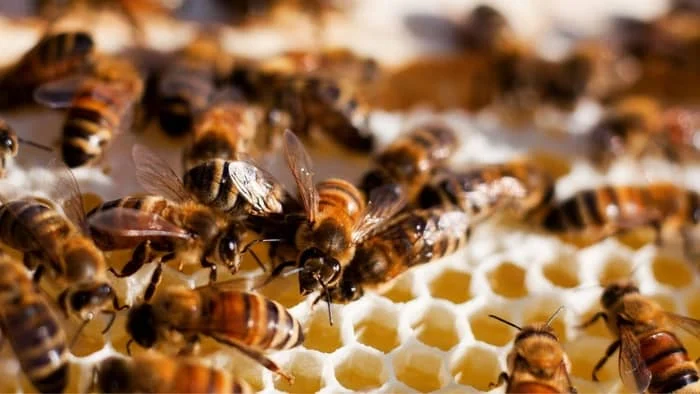
Learn more about: Buckfast Bees
Carniolan vs Russian Bees
There is a lot of debate about this. Some forums insist that Russian bees are really just Apis mellifera caucasia bees. The scientific evidence suggests they are different, being more similar but distinct from Apis mellifera caucasia.
Overwintering
Both Carniolan and Russian bees have relatively high overwintering success rates and an ability to form a tight winter cluster. The cluster is generally efficient and consumes stores conservatively. A number of beekeepers have found that Russian bees can be a bit too conservative on consuming stores. This means they can enter spring with a small cluster and a lot of stores.
Both Russians and Carniolans can survive a few months without a cleansing flight, making them ideal for colder climate beekeeping.
Swarming
Carniolan bees have a low tendency to swarm. This allows beekeepers to produce honey easily with limited management. Russian bees have a high tendency to swarm. They require regular brood nest inspections to remove queen cups.
Rusian bees are very prone to rapid build-up in bee numbers, and, without careful management, you will mainly convert your honey crop into feral bees.
Honey Production
Carniolan bees seem to be regarded as better honey producers, which falls in line with my experience. Russian bees, due to their swarming tendency can produce lower honey crops. They require a lot more management to achieve higher crops.
Aggression
Carniolan bees are really peaceful bees. Any bee can get riled up if you treat the hive badly, but these bees are very slow to anger. I have actually worked a few Carnie hives without a smoker – just removing honey. This still sends shivers up my spine given my early training with African bees. If you do that with African bees you are flirting with disaster.
Russian bees can be a bit more touchy and require a certain amount of skill to work without creating a hail of angry bees. Smoke is more important with these bees.
Mite Resistance
The general consensus here is that Russian bees have better mite resistance than other races of bees, including Carniolan bees. Carniolan bees are however seen as having excellent resistance to Tracheal mites, and slight resistance to Varroa.
Adaptation To Warmer Climates
Both these bee races fare poorly in warmer climates. They need a cold winter for their natural biology to work. Keeping these bees in a part of the world where they are not shut down by cold for a few months is not advisable.
Looking at the traits of Russian bees, if they were to hybridize with African bees in the Southern US it could be problematic. You would be creating a mite-resistant, swarming prone bee with elevated anger. Probably not an ideal combination.
One also has to question the logic of importing a strain of bees from a cold part of the world and setting up a breeding station in the warm gulf region, but that is another debate for another day.
Ability To Keep Multiple Races In An Apiary
Russian bees most desirable trait is mite resistance. If an apiary has mixed genetics, you will lose most of this benefit. Hence for Russian bees, it is best to keep apiaries unmixed. With Carniolans, you can have other races in an apiary with less problematic consequences. It will not cause much trouble if a few Italian bees drift into the Carnie hives as your pest management strategies for both races are similar.
We hope this article has helped highlight a few differences between Carnies and Russian bees. When choosing Carniolan vs Russian bees work out which works best for you using some of the above guidelines.
Read more about: Types Of Bees
Carniolan Vs Russian Bee FAQs
What are the main differences between Carniolan and Russian bees?
Carniolan bees are known for being gentle and low-swarming, while Russian bees have a high swarming tendency but offer superior mite resistance.
Which bees are better at surviving cold winters?
Both Carniolan and Russian bees are highly adapted to cold climates, forming tight winter clusters to conserve energy and survive long winters.
Do Carniolan bees produce more honey than Russian bees?
Yes, Carniolan bees are often regarded as better honey producers, whereas Russian bees may require more management due to their swarming habits.
Are Carniolan bees or Russian bees more aggressive?
Carniolan bees are peaceful and slow to anger, while Russian bees can be more aggressive and are more likely to sting if not handled carefully.
How do Carniolan and Russian bees handle varroa mites?
Russian bees have excellent resistance to varroa mites, nearly twice that of other bees, while Carniolan bees have moderate resistance, particularly against tracheal mites.
Which bee type is easier to manage in an apiary?
Carniolan bees are easier to manage due to their low swarming tendencies and gentle nature. Russian bees require more frequent inspections and swarm management.
Can Russian and Carniolan bees be kept in the same apiary?
Carniolan bees can coexist with other races in an apiary, but Russian bees should be kept in isolated apiaries to preserve their mite-resistant traits.
How do these bees handle warmer climates?
Neither Carniolan nor Russian bees thrive in warmer climates. They both require cold winters to function optimally and may struggle in warm environments.
Do Russian bees require more food stores during winter?
Russian bees tend to conserve food stores more conservatively than Carniolan bees, which can leave them with smaller clusters in the spring.
What type of beekeeper would benefit most from each bee?
Carniolan bees are ideal for beginners due to their gentleness and low maintenance. Russian bees are better suited for experienced beekeepers who can manage their swarming and desire mite resistance.

Dr. Garth A. Cambray is a Canadian/South African entrepreneur and beekeeper with 28 years of experience in apiculture and specializes in adding value to honey. His Ph.D. research developed a new advanced continuous fermentation method for making mead that has resulted in a number of companies globally being able to access markets for mead. His company, Makana Meadery, exports honey mead to the USA where it is available to discerning connoisseurs. He has also developed technologies to commercially manufacture organic honey vinegar in Zambia for export globally. He holds a few patents globally in the ethanol industry and believes in technology and knowledge transfer for human development and environmental sustainability. One of his proudest achievements is the fact that the wind farm he started at one of his old apiary sites has essentially made his hometown carbon neutral.

